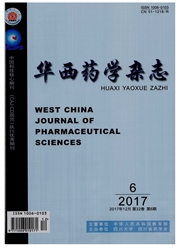

 中文摘要:
中文摘要:
目的研究牛血清白蛋白在脲中的构象变化过程,根据荧光参数的变化,建立蛋白构象与环境变化的关系,从分子水平探讨蛋白质构象变化而致不稳定的原因。方法采用内源性荧光法、荧光淬灭法及荧光探针法研究牛血清白蛋白在脲中的构象变化过程。结果随着脲浓度的增加,牛血清白蛋白中内源性色氨酸荧光峰位先蓝移后红移,荧光强度逐步衰减;而8-苯胺基-1-萘磺酸与牛血清白蛋白结合物的荧光峰位则逐步红移,荧光强度逐渐衰减。结论在变性过程中,牛血清白蛋白的色氨酸残基所处区域构象经历了一个先紧缩后舒展的三态过程;而8-苯胺基-1-萘磺酸的探针结合位点与色氨酸残基可能位于牛血清白蛋白的不同区域,且构象变化更为灵敏。
 英文摘要:
英文摘要:
OBJECTIVE To analyze the fluorescence parameters elucidate the phenomenon on molecular level and establish the relationship between the conformation of protein and the environment.METHODS Intrinsic tryptophan fluorescence,fluorescence quenching and fluorescence probes spectrophotometry were selected to study the denaturation process of bovine serum albumin(BSA) in urea.RESULTS An attenuation of intensity was observed both in BSA and 1,8-ANS-BSA conjugates with increasing the concentration of urea.A red shift on fluorescence emission peak occurred on the 1,8-ANS-BSA conjugates,while the same result appeared on BSA only after a blue shift.CONCLUSION It was shown that the denaturation process of BSA in urea was consistent with a three-state model,and the conformational changes of the binding site on BSA of ANS were much more sensitive than that of tryptophane residue.
 同期刊论文项目
同期刊论文项目
 同项目期刊论文
同项目期刊论文
 Development of Quantitative Structure-Property Relationship Models for Self-Emulsifying Drug Deliver
Development of Quantitative Structure-Property Relationship Models for Self-Emulsifying Drug Deliver 期刊信息
期刊信息
